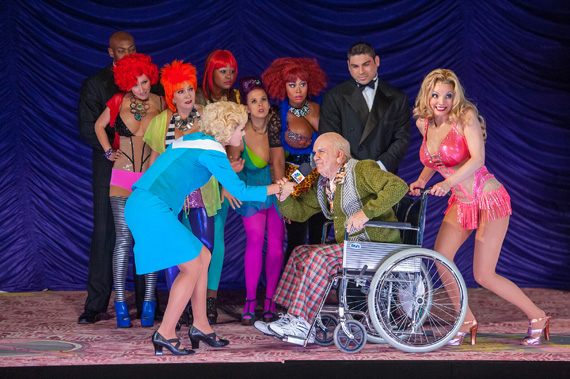New York City Opera Bankruptcy and the Future of City Arts Funding Discussed Among Experts at Crain’s Arts & Culture Breakfast

(© Buck Ennis)
Early Monday morning, members of the New York not-for-profit arts community gathered at the Con Edison Conference Center for an Arts & Culture Breakfast and panel discussion sponsored by Crain’s New York Business. The event, entitled “Keeping the Arts & Culture Industry on the Next Mayor’s Agenda,” was appropriately held just days after New York City Opera’s saddening announcement that it will close its doors after 70 years as a central part of Manhattan’s cultural landscape. With only one month left in the mayoral race between republican candidate Joe Lhota and Democratic candidate Bill de Blasio, professionals in the fields of arts administration, development, and programming offered their perspectives on the road ahead for nonprofit arts organizations as the period of political transition draws nearer.
Vice President and Publisher of Crain’s New York Business Jill Kaplan introduced keynote speaker Emily Rafferty, president of The Metropolitan Museum of Art. Rafferty laid the foundation of the morning’s discussion with a series of financial statistics, making the case for arts and culture as an essential component of the city’s economy. One striking statistic that stood out among the plethora of numbers unloaded on the attendees was an analysis of the economic benefits brought to the city by The Metropolitan Museum of Art alone. According to Rafferty, the 2.3 million patrons who the Met welcomed this past summer (77% of whom were out-of-town visitors) contributed $742 million to New York City’s summertime spending, translating to $74 million in city and state tax revenue. “Money we get from the city allows us to make money for the city,” Rafferty confidently stated with that impressive calculation validating her words.
Following her introductory remarks, the panelists were introduced, with Alair Townsend (Crain’s New York Business columnist and chair of the David H. Koch Theater at Lincoln Center) serving as the discussion moderator. Forming the panel were Yvette Campbell, president and CEO of Harlem School of the Arts; Karen Brooks Hopkins, president of the Brooklyn Academy of Music; Ed Henry, president and CEO of the Doris Duke Charitable Foundation; and Claudia Wagner, joint chair of the New York City Government Practice Group of Manatt, Phelps & Phelps LLP.
With the New York City Opera’s bankruptcy announcement looming overhead as an ominous symbol of the direction of city arts funding, the panelists analyzed the various factors that they believe contributed to the organization’s collapse. Campbell offered a particularly pragmatic perspective, speaking from the unique position of someone whose organization was saved from the brink of failure. She took the helm of Harlem School of the Arts in 2011 after the organization declared bankruptcy in 2010, and has managed to return the school to a state of financial stability. “You have to have a clear plan of how to get out…Decide that you have to shake it up and change your model and make the model smaller than you thought,” she said in reference to the cut of her own operating budget from $5.5 million to $3.4 million. “There was a lot of learning in Harlem School of the Arts history that I would implore other organizations to learn from.”

(© Stephanie Berger)
Hopkins took a more sentimental stance. As President of the Brooklyn Academy of Music, which recently collaborated with the New York City Opera on the much-talked-about coproduction of Anna Nicole , Hopkins came to the organization’s defense. “The mayor said they did not have a sustainable financial model,” Hopkins recalled, agreeing to the statement’s validity. “But the fact of the matter is, for opera, there really is no sustainable financial model,” a comment met with knowing chuckles and rapturous applause.
Speaking from the other side of the fence as the individual controlling the distribution of the Doris Duke Charitable Foundation’s $1.7 billion in assets, Henry offered some insight on the decisions that go into his line of work. “Will the resources you might be able to [offer] this organization really make the critical difference? [Are you] going to be saving something for the moment or is the institution going to go on?” These questions, among others, inform his decisions of whether to bail out other organizations like the New York City Opera that, without a life vest, will be forced to close their doors.
The New York City Opera debate came in the midst of a conversation about the panelists’ hopes and expectations for the future of city arts funding as a new mayor and several new City Council members take their posts (though mentions of the two remaining mayoral candidates’ positions on arts funding remained largely undiscussed). One question repeatedly brought to the floor was whether this perpetual struggle to stay afloat is a biproduct of too many New York City arts organizations battling for funds. Hopkins again made a passionate case, defending the city’s extensive arts community as something that should maintain financial support. “This is our bread-and-butter. Culture is why people come here. Culture is part of the reason why we put up with all the aggravation of living in New York. Culture is part of the fabric of our lives and we should be investing in it,” Hopkins boldly asserted.
She continued, venturing modestly into the much-avoided realm of political commentary. “The job of government is to solve problems and to invest and reinforce assets. I think that we are in the invest-and-reinforce assets category,” Hopkins argued. “Culture, for what it delivers, in terms of community-building, in terms of tourism, in terms of education, and in terms of the glory of art itself, is a cheap fix. We now have to make that case significantly to the new mayor and to all city council members.”










